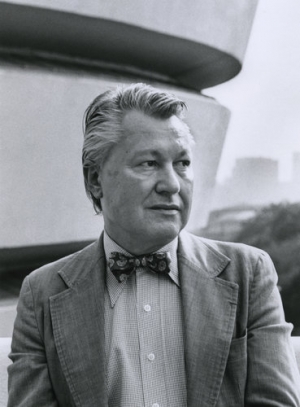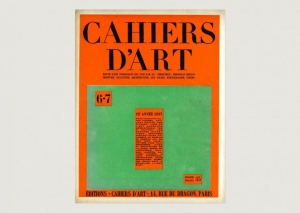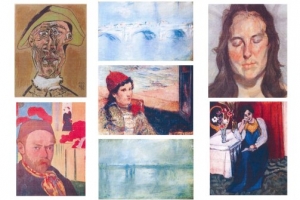|
Displaying items by tag: Picasso
The Pablo Picasso canvas that set a record on May 11 at Christie's for the most expensive work ever sold at auction, at $179.4 million, may have gone to a buyer from Qatar.
Unnamed art world sources are telling the "New York Post" that the buyer of "Femmes d'Alger (Version “O")" (1955), was billionaire former Qatari Prime Minister Hamad bin Jassim bin Jaber Al Thani. Buyers at auction typically maintain their anonymity by bidding via phone; the Picasso was won by an anonymous telephone bidder represented by Brett Gorvy, international head of contemporary art for Christie's.
Pablo Picasso’s granddaughter is selling his villa in Cannes and 126 of his ceramics as she tries to shake off unhappy childhood memories of the artist.
Marina Picasso, 64, remembers being taken to the gates of the grand three-storey house, La Californie, by her impoverished father, Paulo, to beg for handouts from an indifferent Picasso.
To a medley of whoops, hollers and gasps on Monday night, Pablo Picasso’s 1955 painting “Les Femmes d’Alger (Version ‘O’)” sold for $179.4 million including fees at Christie’s “Looking Forward to the Past” sale of artworks spanning the 20th century. The price was the highest on record for a work of art sold at auction, the company said, and was well over its estimate of $140 million.
Once the bidding reached $120 million, the Picasso was pursued by five clients on telephones, often in agonizingly slow, $1 million increments, before finally being sold to a buyer represented by Brett Gorvy, Christie’s international head of contemporary art.
Italian police are trying to establish the true owner of a Picasso painting worth €15 m (£11m) after confiscating it from a pensioner who says he was given it for free.
The Rome resident, a former frame-maker, told detectives he received the work in 1978 as a thank-you gift for an act of kindness towards a recently bereaved customer.
A widower had come into his shop in a state of distress after breaking a photo frame in which he kept a picture of his late wife. Touched, the frame-maker replaced the glass for free.
Pablo Picasso is best known for his paintings, bold works such as “Les Demoiselles d’Avignon” and “Guernica” that profoundly influenced the course of modern art.
This fall, the Museum of Modern Art plans to showcase a less-celebrated aspect of Picasso’s output—his sculpture—with a major survey of three-dimensional works that spans the artist’s entire career.
Featuring around 150 pieces from major collections around the world, “Picasso Sculpture” will run from Sept. 14, 2015 to Feb. 7, 2016.
The IRS taxed a Texas tycoon $40.6 million on the false belief he had taken ownership of a treasure trove of art including works by Picasso, Monet and van Gogh, his widow claims in court. Barbara B. Allbritton sued the United States for herself and the estate of her husband, self-made millionaire Joe L. Allbritton, on Jan. 30 in Federal Court.
Joe Allbritton died in 2012 at 87, ending a life fit for the big screen. After a stint in the Navy during World War II, and graduating from Baylor College of Law, Allbritton took out a $5,000 loan to buy land outside Houston. He made a nice profit selling the land, which was used to build a freeway from Houston to Galveston, and founded San Jacinto Savings and Loan.
Hollywood has had HIV and Darfur, fashion has breast cancer, and music now once again has Live Aid, but the art world – as moneyed as any of them – has never had a charity cause to call its own.
Enter Project Perpetual, who on 9 November auctioned off a specially commissioned sculpture by pop artist Jeff Koons for $4m, benefitting the United Nations Foundation. The piece, based on Picasso’s "La Soupe" and titled "Gazing Ball (Charity)," stands six feet tall and is slung with donated Hermès handbags. The animated Phillips auctioneer Simon de Pury pointed out that Koons had made three of each of the 17 pieces in his "Gazing Ball" series – but that this one was in a unique single edition.

Thomas M. Messer, the longtime director of the Solomon R. Guggenheim Museum in New York, passed away on Wednesday, May 15, 2013 at his home in Manhattan. Messer served as the institution’s director from 1961 to 1988 when he retired. Messer also served as the director of the Guggenheim Foundation, which is dedicated to promoting the understanding and appreciation of art, from 1980 to 1988.
During his time at the Guggenheim, Messer helped to establish the museum as of one of the finest art institutions in the world. In doing so, he grew its collection, increased its exhibitions program, improved its publications, and helped it to become a global entity.
Messer vastly expanded the Guggenheim’s holdings by acquiring two major private collections. In 1963, Justin K. Thanhauser, the son of a German art dealer, gave the museum a trove of Impressionist, Post-Impressionist, and early modern works including over 30 Picassos. The second bequest came from Peggy Guggenheim who left her entire collection including an array of Cubist, Surrealist, and Abstract Expressionist works to the Guggenheim Foundation. The collection operates as a museum known as the Peggy Guggenheim Collection.
Born in Eastern Europe in 1920, Messer arrived in the United States in 1939. He graduated from Boston University in 1942, joined the army, and served as an interrogator for military intelligence in Europe. After the war, he stayed in Europe and studied art at the Sorbonne. Upon his return back to the United States, Messer was named director of a small museum in New Mexico. He eventually earned a master’s degree in art history from Harvard and was soon appointed director of the Institute of Contemporary Art in Boston.
While he has no surviving family, Messer leaves behind a legacy of diplomatic leadership as well as one of the finest art institutions in the world.

The publisher and art critic, Christian Zervos, founded the French art review, Cahiers d’Art, in 1926. The magazine ran without interruption from 1941 to 1943, until 1960 and featured artists such as Picasso, Matisse, Braque, Leger, Ernst, Calder, and Giacometti. Known for its striking layout and abundant photography, Cahiers d’Art also featured reviews written by the likes of Ernest Hemingway and Samuel Beckett. After being out of production for more than fifty years, Cahiers d’Art has been reborn.
Swedish collector and entrepreneur, Staffan Ahrenberg, bought the dormant publication after he walked by the still-operating Cahier d’Art gallery along the rue du Dragon in Paris. Ahrenberg re-launched Cahiers d’Art with former Art Basel director Sam Keller and the renowned curator Hans Ulrich Obrist as editors. The first issue features Ellsworth Kelly, Cyprien Gaillard, and Sarah Morris. As in the past, Cahiers d’Art will not contain advertisements nor will it follow a regular production schedule.
Major art world players including Larry Gagosian, Guggenheim boss Richard Armstrong, and Alfred Pacquement of the Pompidou Centre gathered in a tiny Left Bank gallery in Paris to celebrate the review’s return.

The victim of a devastating art heist that took place last Friday, the Kunsthal Museum in Rotterdam claims their security system is not to blame. The Museum’s director Emily Ansenk shot down allegations that a rear emergency door had been left open. However, police are investigating whether or not there was someone in the museum after hours that could have opened the door for the thieves, as there were no signs of forced entry.
After robbers swiped seven artworks including paintings by Picasso, Matisse, and Monet, the Kunsthal became the subject of intense scrutiny. The Museum admitted to Dutch police that there were no security guards on duty when the robbery occurred. An external security firm was the first to respond when the Museum’s alarm went off. Museum officials claim that their security system, which relies solely on alarms and security cameras, is state-of-the-art.
Late on Friday, police released three grainy surveillance photos of the burglars exiting the Museum out of a back door. While their faces were not visible, police hope that the bags the thieves were carrying are recognizable. Police proceeded to post leaflets around the neighborhood, asking potential witnesses to step forward.
|
|
|
|
|